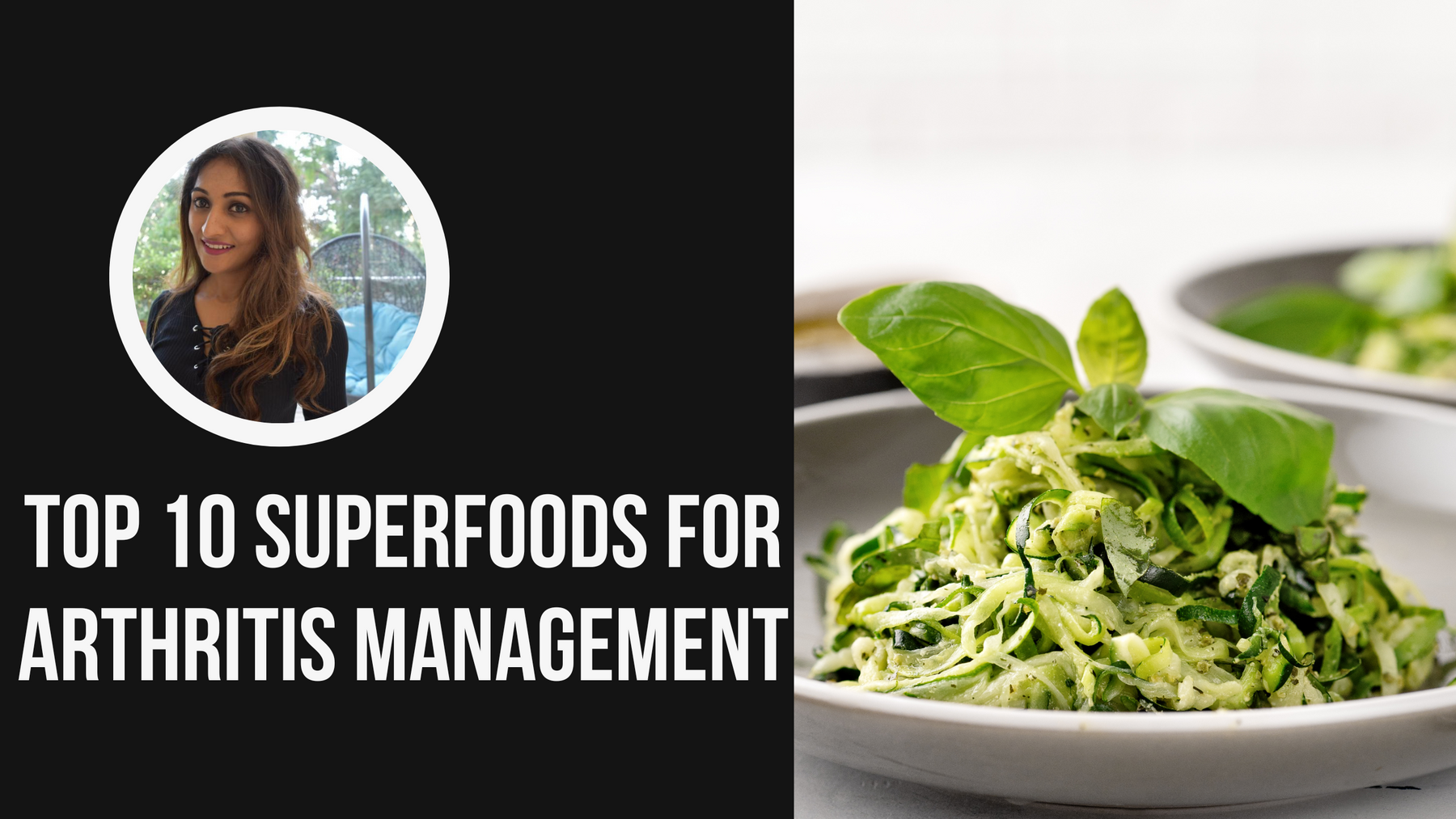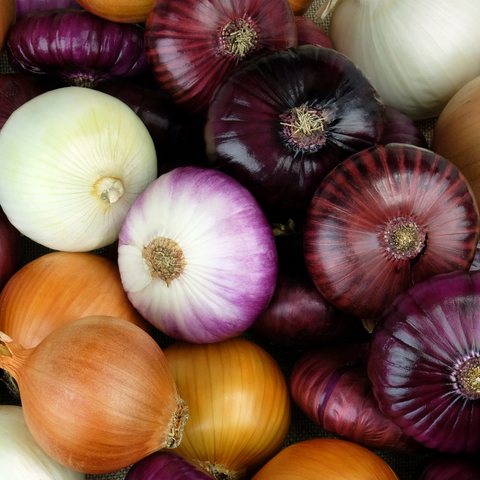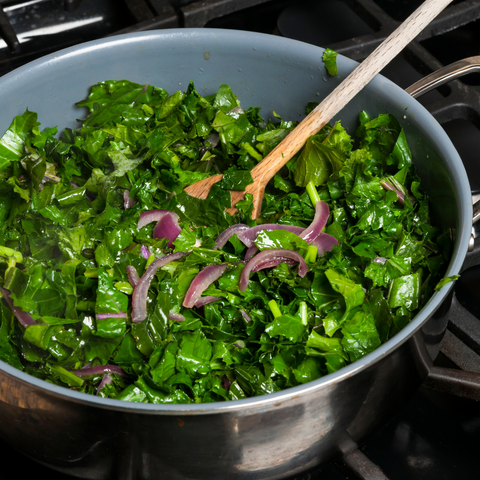
Top Ten Indian Superfoods for Arthritis Management.
Table Of Content
The word “arthritis” means “joint inflammation. It refers to over 100 types of conditions that cause inflammation and damage in the joints and the tissues around the joints.

Some of the most common symptoms are:
- Joint pain: Joint pain's can be frustrating. Working with clients, I have realized that the pain may start with smaller joints like those of the fingers, before progressing to all the joints.
- Stiffness: Specifically morning stiffness. Some clients of mine started of by having to take as long as 30 minutes to just get out of bed in the morning. With sustainable lifestyle and nutritional changes, however, this symptom is the first to improve.
- Swelling: Some people with arthritis may experience swelling in one or more joints. The swelling may be red and warm to the touch and also might have triggers such as over exertion.
- Reduced range of motion: Arthritis can make it difficult to move your joints through their full range of motion. Our first goal when working with clients for arthritis management is to restore ADL (activities of daily living), meaning, restore muscle function and range of motion so clients can perform simple movements like buttoning their shirts, combing their hair, filling a glass of water etc.
- Weakness: The muscles around your joints may become weak due to arthritis. This is often because of lack of use. If you have constant knee pain, you are less likely to climb stairs to exert the knee further. Thus, the muscles supporting the knee lose their function and strength. When working with our clients, we have in- house physiotherapists that help the clients exercise in a pain- free range of motion to restore muscle strength and function. This is very important.
- Fatigue: People with arthritis often experience fatigue, which is a feeling of tiredness or lack of energy. This fatigue can make it difficult to do even simple tasks. Once again, with minimal lifestyle and nutritional changes, fatigue often reduces.
Managing arthritis demands a holistic approach. Nutritional and lifestyle changes must be made simultaneous to alternative therapies and structured fitness regimen. Watch one of our clients talk about her experience and how she overcame osteoarthritis:
Stress on our joints tends to increase with age, it’s an inevitable part of growing older. But, we can prevent joint problems by staying active and maintaining a healthy weight. Limiting foods that stoke inflammation like dairy, oils, processed foods, and sugar.
Let's Review:
- the various types of arthritis, and, how its diagnosed
- its alarming prevalence in our country.
- the top superfoods to support arthritis management, and,
- which foods to avoid.
Read On!
What are the different types of Arthritis?
Arthritis isn't one disease, but rather a collection of conditions affecting joints. Various underlying mechanisms can damage joints, leading to different types of arthritis. These include inflammation, wear-and-tear, infections, and immune system dysfunction.
Genetical factors and individual immune response by the gene can be another contributor in the type of arthritis you might have.
While there could be over a 100 types of arthritis, let's explore some that my team and I have experience working in.
- Osteoarthritis(OA)
By far the most common type of arthritis. Occurs in the hands, spine, hips, and knees. The gradual cartilage breakdown due to age is the most common reason for OA.
OA is a disease of the entire joint mechanism. It weakens bones in affected joints and deteriorates the connective tissue that holds the joint together and damages the joint lining.
- Autoimmune Inflammatory Arthritis
A healthy immune system is protective. But when the immune system goes on an overdrive, it can lead to chronic inflammation and pain. Imagine having a fever (essential to fight toxins that have entered the body), but one that just does not go away.

Autoimmune Inflammatory Arthritis can affect younger individuals, unlike osteoarthritis and can manifest in different forms such as Ankylosing Spondylitis (AS), Psoriatic Arthritis (PsA) and the most common one Rheumatoid Arthritis (RA). Rheumatoid Arthritis is said to affect upto 1% of the global population.
The youngest client we have had for Ankylosing Spondylitis was of 25 years in age. Working consistently for a little short of a year, she found drastic improvement in her inflammation, activities of daily living and also overall mood.
This is why inflammatory arthritis is also an autoimmune disease. The immune system is not able to distinguish between good/bad and attacks the body it’s supposed to protect.
Rheumatoid arthritis (RA) is the most common form of autoimmune inflammatory arthritis.
- Infectious Arthritis
As the name suggests, it is triggered by a bacterial, viral, or fungal infection. Originating from an infection is a part of the body, it finds it way to the nearest major joint, usually the knee.
Treating this requires draining joint fluid. To remove infected fluid and halt any further joint damage.
- Gout (Metabolic Arthritis)
Caused by a build-up of painful uric acid crystals in the joint.
Uric acid develops on the breakdown of purines. These compounds are found in human cells and foods, especially red meat, seafood, and alcohol.
When healthy, the body gets rid of excess uric acid. Else, it builds up in joints, leading to intense pain. Felt in the big toe.
How is Arthritis Diagnosed?
When a client comes to us, we spend a good 90- 120 minutes to just understand the case history, background and medical history.
Think of our team as a detective, piecing together clues to solve the mystery of your joint pain. Our doctors and nutrition coaches work side- by- side to help you understand your health status better: Here's what goes into their investigation:
1. The Interrogation: Buckle up for some questions! Our doctor will delve into your medical history, family history (arthritis can be hereditary), and details about your pain – location, intensity, duration, and anything that makes it better or worse. The second part of the interrogation is conducted by me personally to understand your exposure to heavy metals in the past, emotional trauma growing up, current exposure to endocrine disrupters etc.

2. The Physical Exam: Time to get hands-on. Our doctor's will assess your joints for swelling, warmth, tenderness, and range of motion. They might even perform specific tests to check for joint instability or inflammation. If you do not stay in the same city as our center, our team might ask you for a referral note form your physician.
3. Lab Detectives: Blood tests can reveal markers of inflammation, specific antibodies indicative of certain types of arthritis, and even rule out other conditions mimicking arthritis symptoms. This is very important as you do not want to get on any medication to treat arthritis when you really might not even have arthritis.
4. Imaging the Evidence: Next we suggest to move to X-rays. They offer a snapshot of your joint structure, revealing bone damage or narrowing of joint spaces. For a more detailed look, CT scans or MRIs might be suggested, especially if other conditions are suspected.
5. Putting it All Together: Based on the collected clues, your doctor will reach a diagnosis. Remember, "arthritis" isn't one disease, but an umbrella term for over 100 conditions affecting joints. Identifying the specific type is crucial for tailoring treatment effectively.
Early diagnosis is key! It is much easier for us to work with you and stop the progression of a disease VS trying to reverse it once you already have it. Don't ignore persistent joint pain, stiffness, or swelling. By understanding the diagnostic process and seeking professional help early, you can work with your doctor to manage your arthritis and live an active, fulfilling life.
Wondering what our approach is like to treating arthritis? Here is a detailed blog I wrote on RA:
Arthritis in India
Did you know, Arthritis affects 15 percent of India's population, i.e., 210 million?
Globally, we contribute to almost 40% of the global numbers!
Our lifestyle and current eating habits are a huge contributor's to our current health condition and progression. Lack of knowledge and fear towards medical testing can further delay treatment. This leads to faster progression of the disease and slower rates of reversal.
Early treatment is key to managing arthritis.
Is Arthritis Related To Your Gut Microbiome?
Trillions of microorganisms live in your gut, skin, and mouth. Collectively, they are called the microbiome. They regulate the immune cells throughout our body. This protects you against toxins attacking the body.
This essential ecosystems get thrown out of balance due to:
- poor eating habits,
- taking too many antibiotics,
- elevated stress levels,
- heavy metal exposure and much more.
Disruption to the gut microbiome eventually impacts all major systems of the body.

Now one very interesting study, that tested the urine samples of RA patients showed the presence of inflammatory bacteria called Proteus Mirabilis.
The theory is that when our body releases anti- bodies to fight Proteus Mirabilis, the antibodies also end up attacking some of the healthy joint tissues. This phenomenon in science is called molecular mimicry.
By the above theory, if we can get rid of Proteus Mirabilis, the body should stop attacking healthy joints and thus prevent the progression of RA. Indeed, this is exactly what happens! By just changing one's diet to support a healthier microbiome environment, RA sufferers experienced:
- Reduced morning stiffness: Time cut in half!
- Lower pain scores: From 5 to less than 3 out of 10.
- Less disability: Feeling better, stronger grip, fewer tender joints.
- Weight loss and lower inflammation: Reduced blood markers.
This is also what we see with most of our clients. What is this dietary protocol that promises to show such massive improvement? A plant-forward diet.
Want more information on taking care of your gut-health? Watch this:
What Superfoods Help My Clients With Arthritis Management?
Our approach to Arthritis Management is a combination of sustainable lifestyle changes, nutritional interventions and a structured activity routine. Here are a few superfoods that help our clients.
- Topical Application of Olive Oil:
Emphasis on the work tropical. Topical use of olive oil has promising results in managing arthritis. Particularly osteoarthritis of the knee.
Just using as little as 10 drops of good quality olive oil, and rubbing it on the knee's thrice a day has significant benefits. Now olive oil might not have the same benefit when consumed though. Thus, it is important to only use it tropically. Olive oil, just like with any other type of oil, can be inflammatory when consumed in large quantities. Ideally, we want our clients to stay on an oil- free diet when managing inflammation.
- Pomegranate:
Pomegranates have incredible antiviral properties. A true superfood.
It has bioactive compounds polyphenolic, anthocyanin, and flavonoids. These have amazing antioxidant properties. These flavonoids combat pain & inflammation. A crucial aspect of effective arthritis treatment.
I suggest my clients eat one pomegranate per day, everyday. Within a few weeks, you are sure to see an improvement in your joint- pain symptoms.
- Flaxseeds:
Don't be fooled by their small size. Flaxseeds are nutritional powerhouses. With all the potential to alleviate arthritis symptoms.
Some remarkable compounds make flax seeds a health-boosting phenomenon. They are rich in alpha-linolenic acid (ALA), constituting 57% of their fatty acids. Besides managing pain, ALAs have a tremendous ability to lower cholesterol and blood pressure levels.
I suggest my clients eat 2- 3 tbsp of ground flaxseed powder per day. You also want to make sure it is relatively freshly ground, thus, avoid grinding more than a week's worth supply.
- Onions:
Onions aren’t just an awesome flavouring ingredient. They are rich in super- components called Allicin that boost immunity, reduce inflammation and also aid in supporting a healthy gut.
Plus, loaded with healthful antioxidants and flavonoids that fight against arthritis. Onions are interestingly also helpful in managing menstrual pain.
A healthy gut microbiome is crucial for overall health, potentially influencing inflammation. Onions, containing prebiotics like fructans, might contribute to a balanced gut environment.
I suggest my clients include upto 1/2 a raw onion with meals per day. What is even more beneficial? Chop the onions and leave them at the kitchen counter to sit for 20 minutes before consumption. This releases the aromatics trapped within the cell walls that further aids with inflammation management.

- Cruciferous Vegetables:
Cruciferous veggies include cauliflower, cabbage, broccoli, Kale, Bok Choy and much more. Very rich in a compound called sulforaphane.
Shown to slow down cartilage damage. Eating more cruciferous vegetables is associated with lower levels of inflammatory cytokines. This is one food group I insist all clients to include, no matter what the age group or health status. Personally, one bowl of soup made from cruciferous vegetables is a staple at our home.
- Amla:
Amla boasts impressive anti-inflammatory properties. Did you know Amla is the richest food group when it comes to inflammation management? Richer than berries even. Just one amla per day is a cure all to various types of chronic diseases.
It also has an exceptionally high vitamin C value (20x that of most citrus). Vitamin C is commonly referred to as the anti- oxidant vitamin.
Amla has powerful blood pressure and blood glucose lowering effects too. It also helps you fight against obesity, a very controllable arthritis risk factor. Its immunity-boosting properties help protect your body from infections that could weaken joints.
- Green Leafy Vegetables
Energy production processes in our body produce harmful byproducts called free radicals. Free radicals damage cells and contribute to developing arthritis and inflammation.

Leafy greens are rich in vitamins A, C, and E, which act as antioxidants. These antioxidants help combat free radicals, harmful molecules that can contribute to inflammation throughout the body, including in joints.
Eat enough (your body weight in kgs worth in grams), of green leafy veggies like Kale, Phudina, Dill leaves etc per day. See what grows seasonally around you.
- Pulses
Pulses are a great source of protein and fibre, which are essential for maintaining a healthy gut. As addressed earlier in this article, keeping those microbiomes happy, they will keep your joints happy too!
Pulses are rich in antioxidants and anti-inflammatory compounds that help manage arthritis symptoms. If pulses give you a tummy ache, introduce them slowly, increase their soaking time and cook them very well. Starting with lentils and easy to digest sprouts might also be a great idea.
Worried about the carbs in pulses? Read this:
Is a Low- Carb Diet Really Helpful?
- Garlic
Garlic is a member of the allium family, which also includes onions and leeks.
The sulfur compounds found in garlic, particularly allicin, which is released when garlic is crushed or chopped, are thought to reduce inflammation and oxidative stress in the body. This can potentially alleviate pain and improve joint health for individuals suffering from arthritis.
Further, garlic has been suggested to enhance the immune system, which might play a role in preventing and managing autoimmune conditions, including some forms of arthritis. Its natural compounds can help in modulating the immune response, potentially reducing the severity of symptoms.
Foods To Avoid.
As important as it is to eat the right food groups, it is equally important to avoid certain food groups that is causing inflammation in the first place. I consider the foods to be avoided more important than the foods to be consumed. If your nutrition is doing more harm than good, you will continue taking two steps back for every step forward.
Here are the food groups to watch out for:
Dairy
Dairy and products containing dairy are some of the most inflammatory foods.
Trust me, Milk is SLOWLY poisoning you!
Arthritis patients also complain of having a severe intolerance to milk. It's because their bodies develop antibodies to combat milk proteins. These antibodies actually work against the body and lead to auto-immune failures.
Cooking Oils
Refined cooking oils do not support effective arthritis management. Contrary to the popular belief, your joints do not need oil's to function well. Our bodies are not machines.
Oil's additionally generate LDL or bad cholesterol. This leads to inflammation, only worsening arthritic symptoms. Sunflower, corn, soya, and vegetable oil are high in omega-6 fatty acids, known to catalyze inflammation. Keep away from oils as best you can!
Read through the CONS of oil in your food!
Hyper- Palatable foods
Foods that are chemically designed to keep you addicted to them are hyper- palatable foods. Billions of dollars annually are spent by the food industry to kep their products addictive. Consuming packaged and processed foods causes chronic inflammation and amps up the symptoms of arthritis.

Hyper-palatable foods cause the creation of dangerous toxins -advanced glycation end (AGE). AGEs are created when proteins are bound to glucose molecules. As our body’s immune system tries to break these AGES apart, the immune cells release inflammatory cytokines in large quantities. This causes inflammation and enhances the symptoms of arthritis.
As with tackling any lifestyle illness, dealing with arthritis is a journey.
The first step is to arm yourself with knowledge and understanding. Next, comes the most important part. Daily, consistent, lifestyle changes to empower your body to heal itself.As always, I’m here to help you in your health journey.
If you are interested to work with my team, fill in the form below and we will be sure to contact you.
Let's Just Talk. No Obligations.
I do free consultations every Tuesday's and Thursday's. Either way you will get some actionable tips to reach your fitness goals faster.


Leave a comment